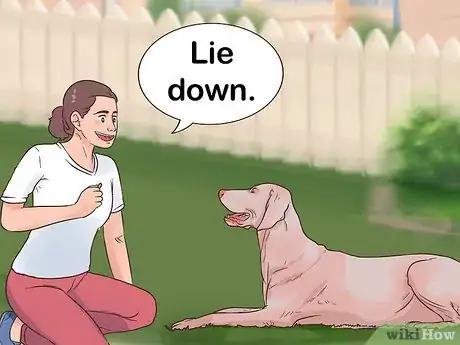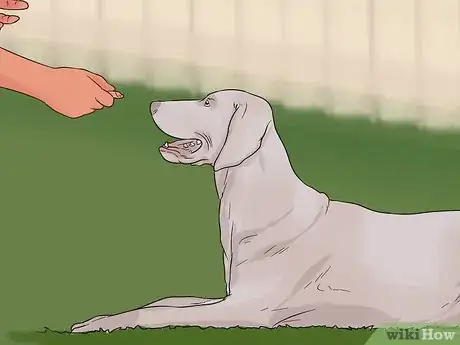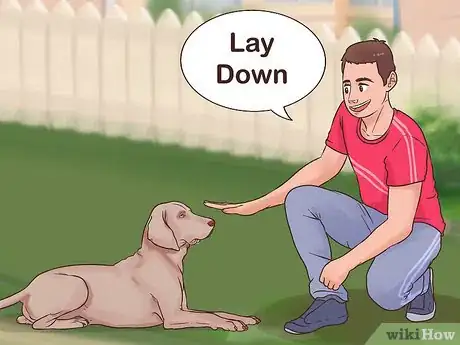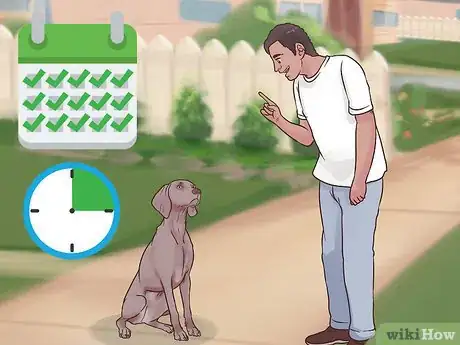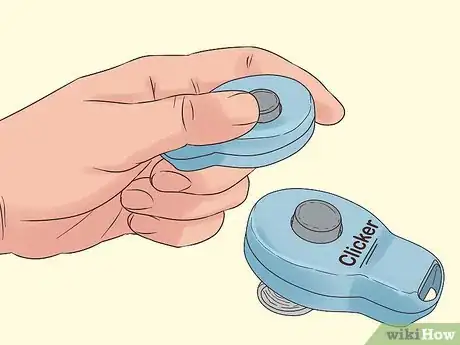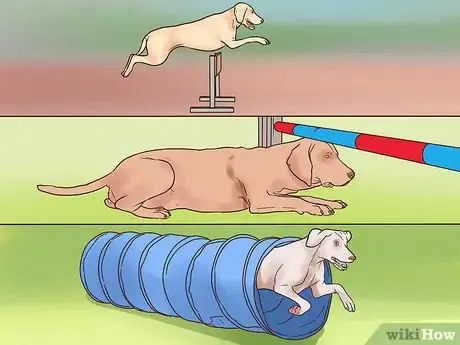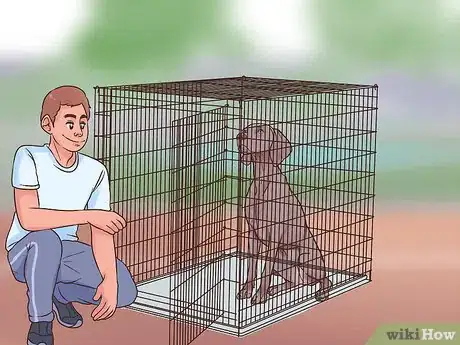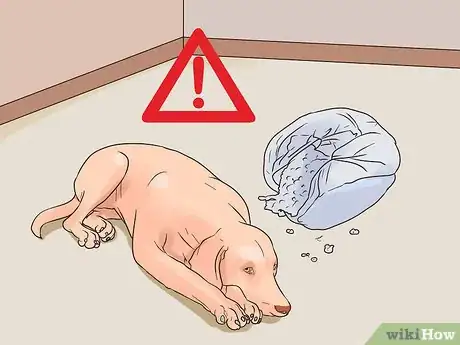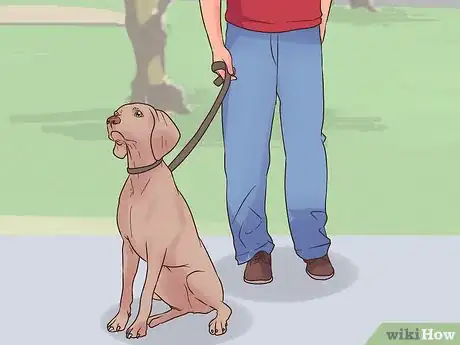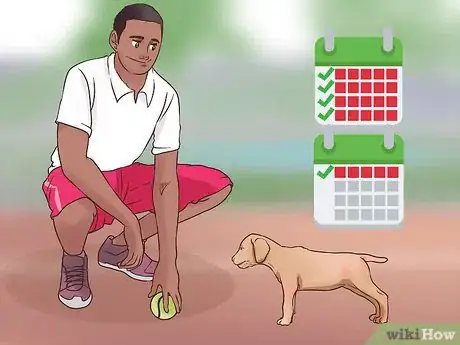This article was co-authored by Ty Brown. Ty Brown is a Dog Behaviorist and Trainer and the Owner of Ty the Dog Guy, a business that provides dog training through digital resources (podcasts, web series, and online courses) along with in-person dog training. Ty has over 17 years of experience in dog training and specializes in both mitigating unruly pet behavior and service dog training. Ty has been awarded the "Best of State Award" for dog training in Utah ten times and his work has been featured in ABC, NBC, CBS, Spike TV, and Entrepreneur Magazine.
There are 8 references cited in this article, which can be found at the bottom of the page.
This article has been viewed 30,530 times.
Weimaraners are large, active dogs that have been bred for hunting and human companionship. They are very smart dogs, so they are especially adept at learning commands and other types of training. If you have a Weimaraner you would like to train, begin training early in its life and focus on consistency and positive reinforcement.[1] If you commit your time and energy to training, you can look forward to good behavior from your Weimaraner.
Steps
Teaching Your Weimaraner to Respond to Commands
-
1Begin training by teaching basic commands. Training usually starts with the command to "sit" because this is a simple action that most dogs can get a grasp on quickly. One way to train a dog to sit is to wait until they are about the sit naturally and then say the word "sit." If you do this enough times, the dog will learn that the word is connected to their action. You can also help guide them into this position with a treat.[2] This command can be followed quickly by other commands such as:
-
2Use reward-based training techniques. Once you give your dog a command and it completes the command, give it a reward, either a treat or praise. Repeat this process of rewarding the dog's correct actions until the dog responds to the command constantly. [3]
- Using treats and praise to reinforce positive behavior is the best way to train a Weimaraner because they are naturally focused on getting food and praise from their humans.[4]
- Don't use punishment when trying to train your Weimaraner. Using physical punishment or anger will only make the dog mistrust you and misbehave more.
Advertisement -
3Establish consistent commands. When training a Weimaraner, it is imperative that you communicate clearly and consistently with it. Establish set words, infections, and physical signals when you first start training your Weimaraner. Having set commands for the dog, such as saying "sit" the same way every time you want it to sit, will ensure that your dog understands you.[5]
- For example, say "lay down" in a calm voice at the same time as you move your outstretched hand in a downward motion. Do this combination every single time you ask the dog to lay down.
-
4Do training sessions daily. Daily training can vary from short 15 minute sessions to longer 1 hour sessions, depending on your dog's abilities, age, and attention span. In these sessions you should focus on both keeping established commands fresh in the dog's mind and introducing new skills. These daily sessions will help the dog progress quickly in its training.[6]
- A Weimaraner will benefit greatly from daily training with you because these sessions give it mental stimulation and one-on-one attention from you.
Doing Advanced Training
-
1Consider clicker training your Weimaraner. With clicker training, you use a sound to tell your dog when it has completed the action you asked it to do before you give it a treat. The clicker noise works well for training because it makes it clear to the dog what action it is getting a treat for.[7]
- If you don't use a clicker, the dog may not know why it is getting a treat.If you want to teach your dog to do a wide variety of skills, clicker training can be a good communication tool for you to use.
- Weimaraners in particular are good at responding to advanced training techniques such as clicker training because they are smart and people-focused dogs.
-
2Break complicated commands into parts. Even a smart dog like a Weimaraner may need some help learning complicated skills, such as going through an obstacle course. For example, if you want your dog to do an agility course, train it to do each part separately. First it will need to learn to jump, then crawl under obstacles, then go through tunnels, and so on. Once the dog responds reliably to the commands, they can be combined.[8]
- If you want your dog to do these types of activities, just remember to teach it a little bit at a time. With enough repetition and patience, most Weimaraners can learn a variety of skills.
-
3Prevent separation anxiety. Focus on giving your Weimaraner lots of daily exercise and toys to occupy its time while you are away. Crate training your dog can also be a good way to eliminate mischief caused by separation anxiety when you are gone.[9]
- Weimaraners are known as people dogs, meaning they have been bred to be good and attentive companions for people. However, this means they can become agitated and destructive when you are not around.
- To override this type of behavior, you should train your dog from an early age to be comfortable with being alone.
-
4Eliminate problematic behaviors. If you see your dog doing something wrong, redirect it immediately. Once it has been redirected, give it positive reinforcement for doing the good behavior it has been told to do. Be consistent with discouraging bad behavior, because if your dog does develop bad behaviors it can be hard to break the habit.
- Some bad habits that should be eliminated include unwanted chewing, pulling on a leash, jumping up. and barking
- If your dog is well trained, including consistent training sessions, you can eliminate most unwanted behaviors that develop.
Ensuring the Training is Successful
-
1Socialize your Weimaraner. Take your Weimaraner out to a variety of people and places, including parks, city streets, and natural places from the time it is 7 weeks old. Make sure that the dog is meeting new people daily, if possible, so it understands that having short, neutral interactions with strangers is a normal part of daily life.[10]
- In order for your Weimaraner to develop a good personality and disposition with strangers, it needs to be exposed to a wide variety of people and places from a young age.
- However, you do need to be cautious about what dogs you expose your puppy to before it has completed its immunizations, usually at around 12 weeks old. It should not be around dogs you don't know and areas where dogs congregate for fear of it getting a communicable disease, such as parvovirus.[11]
-
2Start training early in your dog's life. The earlier you start training, the better. A Weimaraner can start basic training sessions when it is as young as 5 weeks old, although most dogs don't start training in earnest until they are a couple months old. These sessions should be short and basic, but they will create a foundation for later training.[12]
- Early training sessions should only be a few minutes long, as a puppy can't focus on any one thing for very long.
-
3Exercise your dog before training sessions. Take your Weimaraner for a short walk or run before each training session. You don't want the dog to be exhausted but it should have at least a half hour of activity before you do a session. Otherwise, it may have a hard time concentrating on the training session.[13]
- Weimaraners are active and energetic dogs that tend to have a lot of energy. If you want your Weimaraner to focus on your commands, you should have it expel a bit of that energy before training.
Community Q&A
-
QuestionWould you advise an older senior to have a young Weimaraner (1-2 years old)?
 Community AnswerIf the dog is well-trained before being given to the senior and someone is available to walk the dog regularly and/or take the dog to the park, it could be okay. They're very energetic dogs, so they definitely need regular exercise.
Community AnswerIf the dog is well-trained before being given to the senior and someone is available to walk the dog regularly and/or take the dog to the park, it could be okay. They're very energetic dogs, so they definitely need regular exercise.
References
- ↑ Ty Brown. Dog Trainer. Expert Interview. 4 June 2020.
- ↑ Ty Brown. Dog Trainer. Expert Interview. 4 June 2020.
- ↑ https://www.petmd.com/dog/training/evr_dg_how-to-train-your-dog
- ↑ Ty Brown. Dog Trainer. Expert Interview. 4 June 2020.
- ↑ https://www.akc.org/expert-advice/training/basic-training/importance-consistency-training-dog/
- ↑ https://www.akc.org/expert-advice/training/basic-training/importance-consistency-training-dog/
- ↑ https://www.akc.org/expert-advice/training/basic-training/what-is-clicker-training-a-great-way-to-shape-your-dogs-behavior/
- ↑ https://www.akc.org/expert-advice/training/basic-training/what-is-clicker-training-a-great-way-to-shape-your-dogs-behavior/
- ↑ https://weimaranerclubofamerica.org/Public_Ed/PubEd_Separation_Anxiety.pdf
- ↑ https://www.akc.org/expert-advice/training/puppy-training/puppy-socialization/
- ↑ https://www.petmd.com/dog/conditions/infectious-parasitic/c_dg_canine_parvovirus_infection?page=2
- ↑ https://www.petmd.com/dog/training/evr_dg_how-to-train-your-dog
- ↑ http://www.akc.org/expert-advice/dog-breeding/breeding-tips-best-practices/life-with-weimaraners-tips-from-a-breeder/
- ↑ Ty Brown. Dog Trainer. Expert Interview. 4 June 2020.

